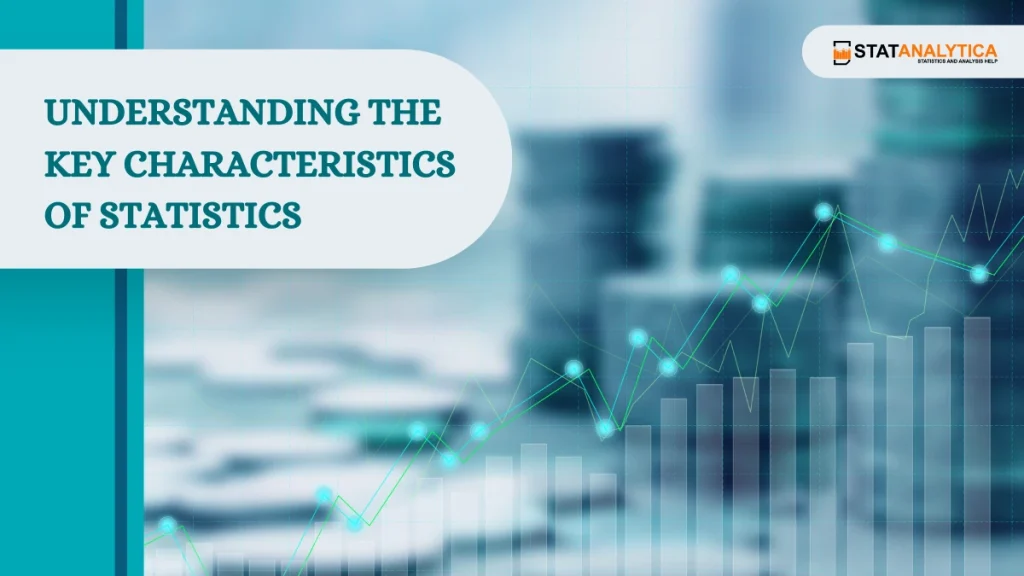Statistics is more than just numbers on a spreadsheet—it’s a powerful tool for understanding and interpreting the world around us. Whether you’re interested in sports, business, healthcare, or social sciences, statistics plays a crucial role in making sense of data. In this blog, we will dive deep into the key characteristics of statistics, making it easy for students to grasp its importance and applications.
What is Statistics?
Table of Contents
In simple terms, statistics is the branch of mathematics that deals with the collection, analysis, interpretation, and presentation of data. It’s all about understanding information through numbers and making informed decisions based on that data. Whether you’re calculating averages, determining probabilities, or interpreting survey results, statistics helps you find answers in a sea of data.
Why is Statistics Important?
Statistics is everywhere. From businesses making marketing decisions to scientists testing new medicines, statistics help provide clarity and insight in nearly every field. It enables us to:
- Identify trends
- Make predictions
- Analyze relationships
- Support decision-making
The Key Characteristics of Statistics
Understanding the key characteristics of statistics will give you a clearer idea of how this powerful tool functions in the real world. Let’s explore each characteristic in detail.
1. Data Collection and Aggregation
The first step in statistics is collecting data. Data can come from various sources, such as surveys, experiments, or historical records. However, collecting raw data isn’t enough. It needs to be aggregated (grouped) so it can be analyzed efficiently.
For example, consider a survey asking 1,000 people about their favorite food. You wouldn’t analyze each person’s answer individually—instead, you would group the answers (pizza, burgers, salads, etc.) to understand the overall trend.
Example:
If a survey collects responses from 1,000 students on their preferred study method (group study or solo), the data would be aggregated to find the percentage of students preferring each method.
2. Numerical Representation
Statistics revolves around numbers. Once data is collected, it’s converted into numerical form to facilitate analysis. Numbers provide clarity and precision, allowing us to quantify trends and patterns.
Example:
If 65% of people in a survey said they prefer online shopping over in-store shopping, this numerical representation makes it easy to compare preferences and see trends.
3. Variability in Data
Data is not always consistent. Variability is one of the most important characteristics of statistics because it recognizes that not all data points will be the same. This variation helps identify patterns and understand differences among groups.
Example:
When measuring the height of a group of students, you get a wide range of values. Some students may be tall, others short, and many somewhere in between. This variability is essential for understanding the spread of the data.
4. Comparability of Data
For statistics to be useful, the data being analyzed must be comparable. This means the data should be collected in a standardized way so that meaningful comparisons can be made. Without comparability, the conclusions drawn from statistical analysis may be misleading.
Example:
If you are comparing the test scores of students from two different schools, both schools must have used the same grading scale. Otherwise, the comparison would need to be more accurate.
5. Use of Statistical Methods
Statistics isn’t just about numbers; it involves various methods and techniques to collect and analyze data. Some of the most common methods used in statistics include:
- Surveys: Gathering information through questionnaires
- Experiments: Conducting controlled tests to gather data
- Sampling: Selecting a smaller group to represent the entire population
Example:
A survey conducted among a sample of 500 people about their spending habits can provide insights into the spending behavior of a larger population.
6. Precision in Analysis
Precision is a crucial element in statistics. The goal is to minimize errors and ensure that the conclusions drawn from the data are as accurate as possible. Statistical measures like mean (average), median (middle value), and mode (most frequent value) help summarize and provide precise insights into the data.
Example:
If a class of students has scores of 85, 90, 78, 92, and 88 on a test, the mean score would be the sum of the scores divided by the number of students.
7. Generalization from Samples
Often, it’s not practical or possible to collect data from every single person in a population. Instead, a smaller sample is used, and statistics help us generalize the findings to the larger group. This allows researchers to make educated assumptions about the broader population based on sample data.
Example:
A political poll may survey 1,000 people about their voting preferences. Using statistical techniques, the results from that small sample can help predict how millions of people will vote.
Types of Statistics
Statistics is broadly categorized into two types: Descriptive Statistics and Inferential Statistics. Each has a distinct role in data analysis.
1. Descriptive Statistics
Descriptive statistics involve summarizing and organizing data. These statistics help us describe what is going on in a dataset. Common descriptive statistics include:
- Mean: The average of the data
- Median: The middle value of the data set
- Mode: The most frequently occurring value
Example:
If the ages of students in a class are 16, 17, 18, and 19, the mean age would be the sum of their ages divided by the number of students.
2. Inferential Statistics
Inferential statistics go beyond simple descriptions and help us conclude a population based on sample data. They use probability theory to make inferences or predictions about larger groups from a smaller sample.
Example:
Using data from 500 students, a researcher might infer that 60% of the entire school prefers online learning over traditional classroom settings.
Comparison of Descriptive and Inferential Statistics
| Descriptive Statistics | Inferential Statistics |
| Summarizes and organizes data | Makes predictions based on data |
| No assumptions about a larger group | Assumes the sample represents a population |
| Example: Average height of students | Example: Predicting election outcomes |
Applications of Statistics in Real Life
Statistics isn’t confined to textbooks or classrooms. It plays a significant role in everyday life and across various industries. Here are some key areas where statistics are used:
1. Statistics in Business
Businesses use statistics to make decisions about products, services, marketing, and customer preferences. They analyze trends in consumer behavior to optimize their strategies and maximize profits.
Example:
A company might analyze sales data from the past year to forecast demand for their products in the upcoming year.
2. Statistics in Healthcare
In healthcare, statistics are vital for understanding disease patterns, improving treatment methods, and making medical advancements. Statistics are used in clinical trials to test the effectiveness of new drugs and treatments.
Example:
A clinical trial might use statistics to analyze the success rate of a new medication for treating diabetes.
3. Statistics in Social Sciences
Social scientists rely on statistics to study human behavior, societal trends, and public opinion. By analyzing data from surveys and experiments, social scientists can understand complex social issues and inform public policy.
Example:
A survey on job satisfaction among workers could reveal the factors that contribute to employee happiness and productivity.
4. Statistics in Government
Governments use statistics to make decisions related to economic policies, public health, and national security. Census data, for example, helps governments plan for infrastructure, education, and healthcare services.
Example:
A government may analyze population growth data to decide where to build new schools and hospitals.
Conclusion
In conclusion, statistics is an essential tool for understanding and interpreting the world around us. By collecting, analyzing, and summarizing data, we can make informed decisions and predictions across various fields, from business to healthcare. Understanding the key characteristics of statistics—such as data collection, numerical representation, and the use of statistical methods—helps us better grasp how this discipline works.
How does statistics improve decision-making?
Statistics provide data-driven insights that help individuals and organizations make more accurate and informed decisions.
What are the challenges in using statistics?
Some challenges include collecting accurate data, avoiding biases, and ensuring data is comparable across different sources.
What’s the difference between descriptive and inferential statistics?
Descriptive statistics summarize data, while inferential statistics use sample data to make predictions about a larger population.


